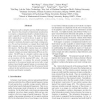Free Online Productivity Tools
i2Speak
i2Symbol
i2OCR
iTex2Img
iWeb2Print
iWeb2Shot
i2Type
iPdf2Split
iPdf2Merge
i2Bopomofo
i2Arabic
i2Style
i2Image
i2PDF
iLatex2Rtf
Sci2ools
CVPR
2011
IEEE
2011
IEEE
Simulating Human Saccadic Scanpaths on Natural Images
Human saccade is a dynamic process of information pursuit. Based on the principle of information maximization, we propose a computational model to simulate human saccadic scanpaths on natural images. The model integrates three related factors as driven forces to guide eye movements sequentially — reference sensory responses, foveaperiphery resolution discrepancy, and visual working memory. For each eye movement, we compute three multi-band filter response maps as a coherent representation for the three factors. The three filter response maps are combined into multi-band residual filter response maps, on which we compute residual perceptual information (RPI) at each location. The RPI map is a dynamic saliency map varying along with eye movements. The next fixation is selected as the location with the maximal RPI value. On a natural image dataset, we compare the saccadic scanpaths generated by the proposed model and several other visual saliency-based models against human eye move...
| Added | 08 Apr 2011 |
| Updated | 29 Apr 2011 |
| Type | Journal |
| Year | 2011 |
| Where | CVPR |
| Authors | Wei Wang, Cheng Chen, Yizhou Wang, Tingting Jiang, Fang Fang, Yuan Yao |
Comments (0)

